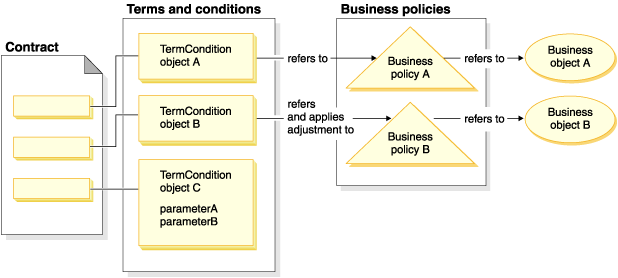
Trading agreements and business policies
One of the key elements of B2B direct commerce is relationship management. A trading agreement is used to manage a business relationship between a buyer and a seller organization. The trading agreement model that is used by WebSphere Commerce supports various types of trading agreements, such as business accounts, contracts, and RFQs.
The main element of a trading agreement is a set of terms and conditions. Each term and condition defines a specific business rule to be used during trading. By using WebSphere Commerce Enterprise, a set of terms and conditions can be negotiated with an RFQ online process, or negotiated offline and then captured with the business relationship management interfaces in WebSphere Commerce Accelerator.
There are several ways to model a term and condition:
- A term and condition that selects one of the predefined business policies, such as a price list and a return policy. Or it can select a business policy that you create. One term and condition object can also refer to multiple business policy objects.
- A term and condition that applies a specific adjustment to the business policy, such as an adjustment to the standard pricing.
- A term and condition that defines a set of parameters that govern a business process. For example, it might specify that a particular fulfillment center is to be used by a specific contract.

- The term "adjustment" refers to a modification to the business policy. As an example, it can be used to apply a discount to the result of a business policy such that a 10% discount gets applied to the standard price. It can also be used to influence the business policy with a set of parameters.
- As an example, in the diagram the TermCondition object A might represent a shipping term and condition object. In this case, the business policy A might represent a shipping mode business policy. The business object A represents the shipping mode "A3" of shipping carrier XYZ.
- As another example, in the diagram the TermCondition object B might represent a price term and condition object that applies a 50% discount of the price that is defined by business policy B. In this case, business policy B is a price policy. The business object B is a trading position container that defines the trading position for the master catalog.
The Extensions to terms and conditions topic provides guidelines for programmers on how to create new business policies and new terms and conditions.
The advanced B2B starter store demonstrates a shipping term and condition object and a price term and condition object in its business flow.